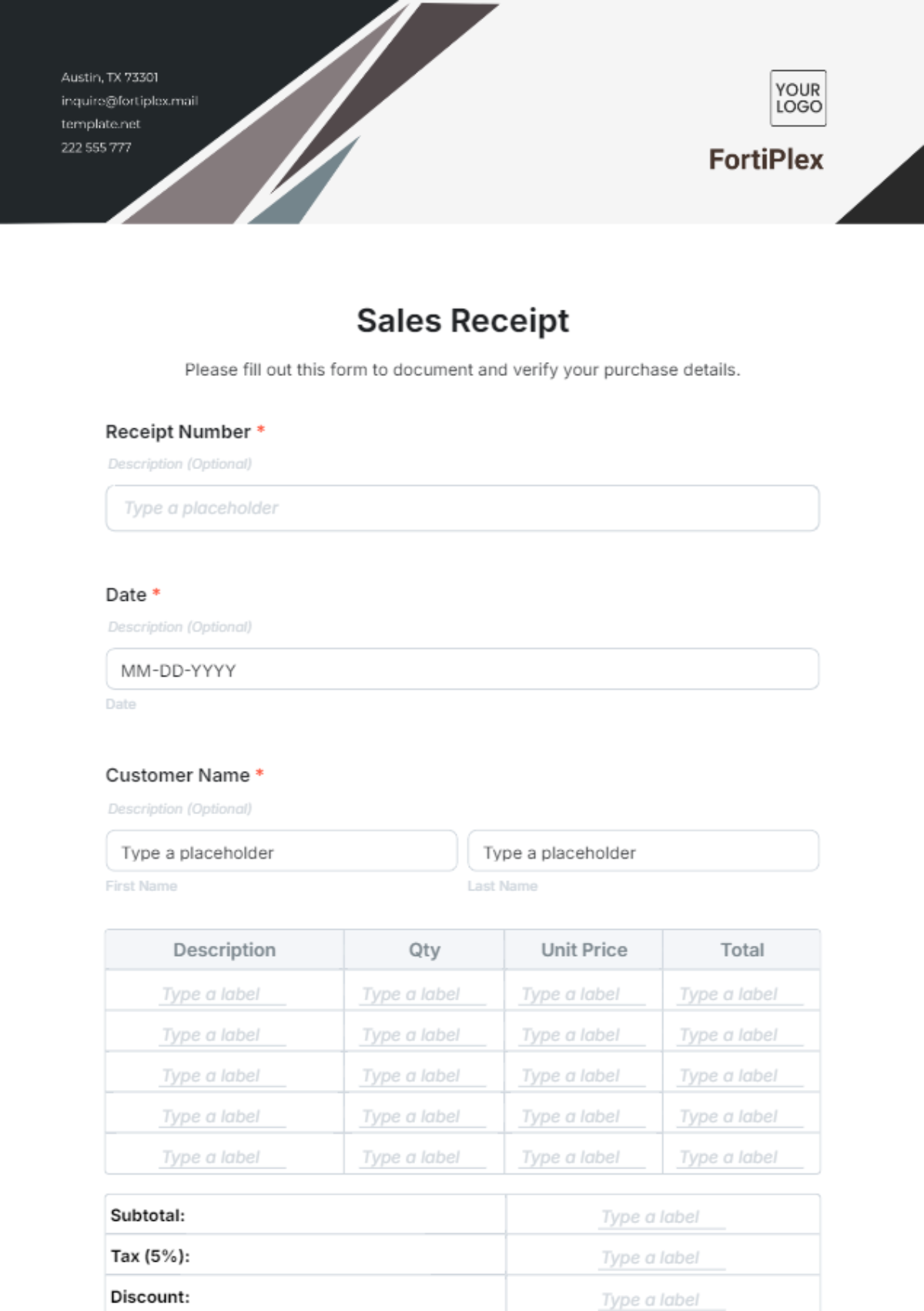Sales Feasibility Study on Implementing a New Commission Model
A. Executive Summary
The purpose of this feasibility study is to assess the viability and implications of implementing a new commission model within our sales organization. The study has concluded that introducing a more performance-driven commission model is a feasible and strategic move. The new model aims to enhance sales team motivation and align compensation with company objectives. Recommendations include a phased implementation approach and ongoing monitoring of its impact.
B. Introduction
As [Your Company Name] continues to expand its product and service offerings, it has become imperative to assess the current state of our sales commission model. This feasibility study serves as a proactive response to the dynamic nature of our industry and the evolving expectations of our sales team. In this introduction, we delve into the primary objectives of this study, the context behind it, and the critical considerations driving this evaluation.
1. Objectives of the Study
Assessment of Viability:
The primary objective of this study is to determine the viability of introducing a new commission model. We aim to evaluate whether the proposed changes align with our company's goals and can be effectively implemented.
Financial Implications:
We seek to gain a comprehensive understanding of the financial impact of the new commission model. This includes an assessment of how it will affect our cost structure, budgetary requirements, and the overall financial health of the organization.
Sales Team Impact:
The motivation and effectiveness of our sales team are of paramount importance. We aim to gauge how the new commission model will impact the motivation, performance, and job satisfaction of our sales representatives.
2. Context and Rationale
Market Dynamics:
Our industry is continually evolving, with changing customer preferences, emerging competitors, and changing product offerings. Staying competitive and responsive to market trends is essential for our continued growth and success.
Sales Team Motivation:
Our sales representatives are the core of our organization’s success. Their dedication and performance directly impact our revenue and market position. Ensuring their motivation and engagement is crucial to achieving our strategic objectives.
Diversity of Sales Efforts:
In our current commission model, there is a focus on the volume of sales. While this has served us well, it doesn't fully capture the diverse efforts of our sales team. We need a model that encourages cross-selling, upselling, and long-term customer relationships.
Alignment with Company Goals:
As we chart a course for the future, it is imperative that our commission model aligns with our organizational goals. These goals include increasing customer lifetime value, fostering sales diversity, and achieving sustainable revenue growth.
This study will provide the insights and data necessary for informed decision-making, ensuring that our sales team is adequately motivated, and our organization remains agile and competitive in the evolving marketplace. The following sections of this study will delve into the current commission model, the proposed changes, market analysis, financial implications, and the expected impact on our sales team.
C. Current Commission Model
Our current commission structure is primarily based on a fixed percentage of sales revenue. Sales representatives receive a [7%] commission on the total sales they generate. While this model has served us well, it may not be motivating sales representatives to explore cross-selling and upselling opportunities.
D. Proposed Commission Model
Our existing commission model, which has been in place for several years, serves as the foundation of our sales compensation structure. This section offers a comprehensive overview of the current commission model, breaking down its components, calculation methods, and performance metrics. This analysis will provide a baseline for evaluating the proposed changes and their potential impact.
1. Components of the Current Commission Model
Our current commission model is relatively straightforward, primarily based on a fixed percentage of total sales revenue generated by each sales representative. The primary components are as follows:
Commission Rate:
Sales representatives are currently compensated at a fixed commission rate of 7% on the total sales revenue they generate. This rate has remained consistent for an extended period.
Sales Targets:
While our commission model is primarily tied to sales volume, we also employ specific monthly sales targets that our representatives are expected to meet. Achieving these targets is a prerequisite for earning commissions.
Incentives:
We offer additional incentives such as bonuses and recognition programs to motivate our sales team further. These incentives are often tied to meeting or exceeding sales targets.
2. Calculation Methods
The calculation of commissions under the current model is relatively straightforward and can be expressed as follows:
Total Commission Earnings = (Total Sales Revenue x Commission Rate) |
For example, if a sales representative generates $100,000 in sales in a given month, their commission earnings would be $7,000 (7% of $100,000).
3. Performance Metrics:
The primary performance metric under the current model is sales revenue. Sales representatives are primarily compensated based on the volume of sales they achieve within a specified time frame. While this straightforward approach has incentivized our team to focus on driving sales, it may not fully encourage efforts related to cross-selling, upselling, and client retention.
4. Current Model's Strengths:
Simplicity:
The current commission model is simple to understand and administer. This has contributed to its stability and consistency over time.
Motivation for Sales Volume:
The model effectively motivates sales representatives to strive for higher sales volumes, aligning with our revenue growth goals.
5. Current Model's Limitations:
Limited Diversification: The model primarily rewards the volume of sales. It does not adequately incentivize cross-selling, upselling, and building long-term customer relationships.
Motivation Challenges: As our product and service offerings expand, the current model may not sufficiently motivate sales representatives to explore the full spectrum of revenue opportunities.
Our current commission model is straightforward and has historically aligned with our focus on sales volume. While it has served us well, its limitations in terms of diversification and motivation for additional sales efforts have prompted us to consider the feasibility of a new commission model that better reflects the evolving dynamics of our industry and our company's strategic goals.
E. Rationale for Change
The decision to explore and potentially implement a new commission model is grounded in a well-defined rationale that takes into account the dynamics of our industry, the need to adapt to changing market conditions, and our organizational objectives. This section delves deeper into the key factors driving this change.
1. Market Dynamics and Evolution:
Our industry is in a state of constant evolution. Market dynamics, customer preferences, and competitive forces are continually shifting. To remain competitive and position ourselves as industry leaders, we must be agile and responsive. The existing commission model was designed during a different market era. It is essential that we adapt to contemporary market conditions and align our compensation structure with the changing landscape.
2. Sales Team Motivation and Retention:
A critical consideration for any commission model is its impact on sales team motivation and retention. While our current model has incentivized our sales representatives to focus on achieving sales targets, it may not sufficiently motivate them to explore cross-selling, upselling, and client retention. In an era where customer relationships are a critical asset, it is imperative that our sales team is motivated to provide comprehensive solutions to our clients and cultivate long-term relationships.
3. Diversity of Sales Efforts:
As our product and service offerings continue to diversify, we must adapt our commission model to reflect the diversity of sales efforts required. Beyond the core function of generating new sales, our sales team's responsibilities have expanded to include cross-selling complementary products and services, upselling to existing clients, and ensuring client renewals. The new commission model should encourage and reward these diversified efforts.
4. Alignment with Organizational Goals:
Our organizational objectives include increasing customer lifetime value, diversifying our revenue streams, and achieving sustainable revenue growth. The commission model should be a tool for realizing these goals. The current model, while effective in driving sales volume, may not align perfectly with these objectives. A new model is needed to better support our broader strategic aims.
5. Innovation and Responsiveness:
In a rapidly changing market, innovation and responsiveness are key. The new commission model must provide room for experimentation and adaptation to rapidly changing customer needs. It should be a tool that empowers our sales representatives to be innovative in their approach, adapt to market shifts, and respond to emerging opportunities.
6. Enhancing the Sales Culture:
Our sales culture plays a pivotal role in our company's success. The commission model is a fundamental element of this culture. The new model should promote a sales culture that is dynamic, customer-centric, and focused on delivering comprehensive solutions to our clients.
The rationale for considering a new commission model is deeply rooted in the need to adapt to current market dynamics, foster a sales culture that embraces diversification and innovation, and align our compensation structure with our organizational objectives. It is an essential step toward ensuring our continued competitiveness, the motivation of our sales team, and our ability to meet the changing needs of our customers.
F. Market Analysis
Our industry peers have already implemented similar tiered commission structures, resulting in enhanced sales performance and increased revenue. This market analysis indicates that adopting a new commission model would align us with industry standards and position us competitively.
G. Financial Analysis
The financial analysis indicates that implementing the new commission model will have a moderate impact on the company's expenses. While commissions will increase for high-performing sales representatives, the potential for increased sales volume and revenue diversification outweighs the additional costs.
H. Impact on Sales Team
The new commission model is anticipated to have a positive impact on the sales team's motivation. By incentivizing cross-selling and upselling, it will encourage representatives to explore more revenue opportunities and provide better customer service. However, it may require a transition period for the team to fully adapt.
I. Implementation Plan
The implementation plan outlines a phased approach. Initial training and communication will introduce the new model, followed by a three-month transition period during which both the old and new commission models will coexist. Ongoing support and feedback channels will be established.
J. Risk Assessment
Potential risks include initial resistance from the sales team, the need for updated tracking systems, and the possibility of unforeseen challenges during implementation. Strategies to mitigate these risks include comprehensive training and transparent communication.
K. Legal and Compliance Considerations
Our legal team has reviewed the new commission model and confirmed its compliance with all relevant labor laws and regulations. It aligns with industry standards and maintains transparency in commission calculation.
L. Stakeholder Input
Feedback from sales representatives, sales managers, and company executives has been solicited and incorporated into the new commission model. Their perspectives have played a crucial role in shaping the proposed changes.
M. Recommendations
Based on the analysis and feedback received, we recommend the following actions, these steps will ensure a comprehensive and responsive approach to the implementation and optimization of the new commission model:
Initiate Implementation:
Commence the implementation of the new commission model, aligning it with the organization's strategic business objectives.
1. Monitor Sales Performance:
Systematically track and analyze sales data post-implementation to assess the impact of the new model on sales performance.
2. Evaluate Employee Feedback:
Regularly gather and review feedback from employees, especially those directly affected by the new commission structure, to gauge their response and adaptability.
3. Analyze Customer Feedback:
Collect and scrutinize customer feedback to understand the external impact of the commission model on customer experience and satisfaction.
4. Adjust Model as Necessary:
Based on the analysis of sales performance, employee feedback, and customer responses, make data-driven adjustments to the commission model to ensure it remains effective and beneficial for both the organization and its employees.
5. Review Revenue Impact:
Continually assess the impact of the new model on overall revenue, ensuring that it contributes positively to the company’s financial goals.
N. Conclusion
This feasibility study has shown that implementing a new commission model is a strategically sound decision. It aligns with industry standards, fosters motivation, and encourages diversified sales efforts. We look forward to enhancing our sales culture and achieving our revenue goals through this transition.















































